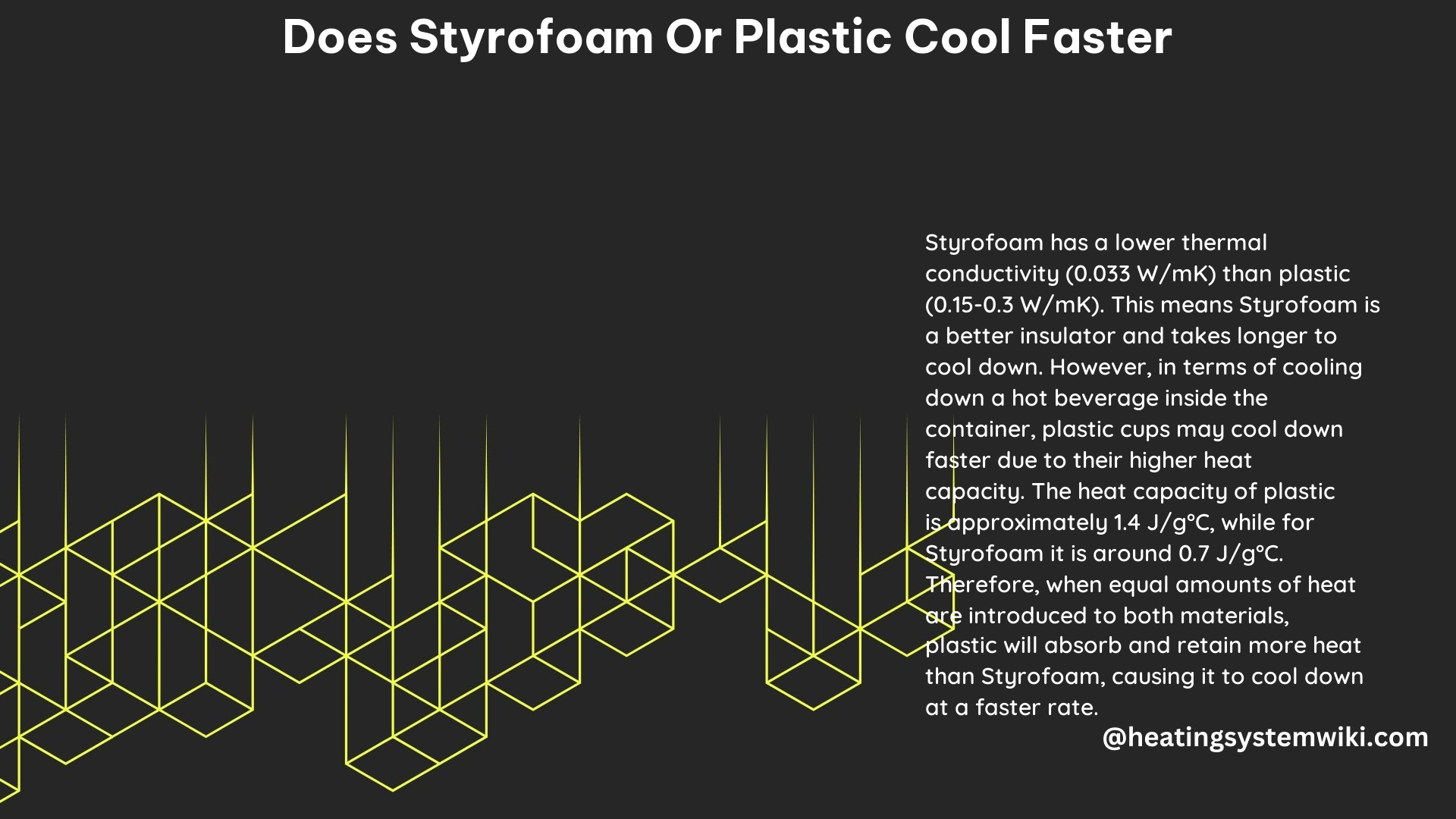Styrofoam and plastic have different thermal properties that affect how quickly they cool down. Styrofoam, with a thermal conductivity of approximately 0.33W(m/K), is a better insulator than most plastics, which have an average thermal conductivity of 0.02-0.05 W/(m/K). This means that Styrofoam is more effective at slowing down the transfer of heat, making it cool down slower than plastic when exposed to a cooler environment.
Thermal Conductivity: The Key Difference
Thermal conductivity is a measure of a material’s ability to conduct heat. The lower the thermal conductivity, the better the material is at insulating and slowing down heat transfer. Styrofoam, with its low thermal conductivity, is an excellent insulator, while plastic has a higher thermal conductivity, allowing heat to transfer more quickly through the material.
| Material | Thermal Conductivity (W/m-K) |
|---|---|
| Styrofoam | 0.33 |
| Polystyrene Plastic | 0.13 – 0.15 |
| Polyethylene Plastic | 0.33 – 0.51 |
| Polypropylene Plastic | 0.12 – 0.22 |
As shown in the table, Styrofoam has a significantly lower thermal conductivity compared to most plastics, making it a better insulator and slower to cool down when exposed to a cooler environment.
Heat Transfer Mechanisms

The difference in cooling rates between Styrofoam and plastic can be explained by the mechanisms of heat transfer:
-
Conduction: Styrofoam’s low thermal conductivity slows down the conduction of heat through the material, while plastic’s higher conductivity allows heat to transfer more quickly.
-
Convection: Styrofoam’s porous structure traps air, reducing convective heat transfer, whereas plastic’s smooth surface allows for more efficient convective cooling.
-
Radiation: Styrofoam’s low emissivity (the ability to emit thermal radiation) means it absorbs and radiates heat more slowly compared to plastic.
These differences in heat transfer mechanisms contribute to Styrofoam’s slower cooling rate compared to plastic.
Cooling Rates in Different Environments
The cooling rate of Styrofoam and plastic can vary depending on the environment they are exposed to:
-
Refrigerator or Cooler Environment: In a cooler environment, plastic’s higher thermal conductivity allows it to cool down faster than Styrofoam. The heat from the container is more efficiently transferred to the surrounding cooler air or liquid.
-
Direct Sunlight: When exposed to direct sunlight, plastic can heat up faster than Styrofoam due to its lower insulating properties. Styrofoam’s better insulation helps it retain heat for a longer period.
-
Room Temperature: At room temperature, Styrofoam’s insulating properties become more apparent, and it cools down slower than plastic, which has a higher heat transfer rate.
It’s important to note that the environmental impact of using Styrofoam or plastic for beverage containers is significant. Plastic water bottles can take up to nearly 700 years to decompose in landfills, and they can leach harmful chemicals when exposed to high temperatures or sunlight. Styrofoam, while a better insulator, is not biodegradable and can also have negative environmental impacts.
Reusable Containers: The Optimal Solution
To address the environmental concerns and temperature regulation issues, reusable containers such as thermoses are the most effective solution. Thermoses, made of materials like stainless steel or double-walled vacuum-insulated glass, can maintain the temperature of a drink for much longer than single-use Styrofoam or plastic containers.
The combination of superior insulation and the ability to reuse the container makes thermoses the most efficient and environmentally friendly option for keeping drinks hot or cold for extended periods.
Conclusion
In summary, Styrofoam cools down slower than most plastics due to its lower thermal conductivity, but it can also retain heat longer when exposed to a warmer environment. Plastic, with its higher thermal conductivity, cools down faster in a refrigerator or cooler environment but can heat up faster when exposed to direct sunlight. Both materials have significant environmental impacts, and reusable containers such as thermoses are the most effective temperature regulators for keeping a drink hot or cold for longer.
References:
– Wilson, K. (2021, July 19). Do drinks stay colder in a plastic or metal container? Retrieved from https://thermtest.com/stay-colder-for-longer-in-a-container-made-of-plastic-or-metal
– Reddit User. (2015, October 14). ELI5: Why do plastic cups “sweat” so much faster than styrofoam cups in the same conditions? Retrieved from https://www.reddit.com/r/explainlikeimfive/comments/3or8m7/eli5_why_do_plastic_cups_sweat_so_much_faster/
– Summer, D. (2018, December 11). What Is a Better Insulator: Paper, Glass, Plastic, or Styrofoam? Retrieved from https://sciencing.com/what-is-a-better-insulator-paper-glass-plastic-or-styrofoam-5117069.html
